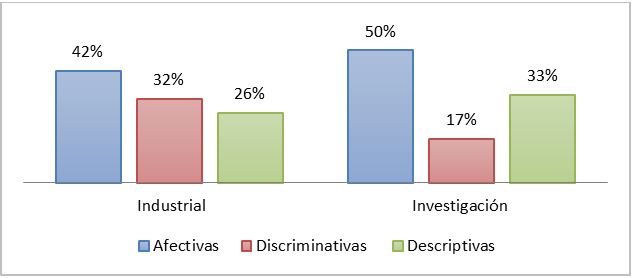Sensory analysis tests for the development of infant cereal products in Venezuela
DOI:
https://doi.org/10.13140/RG.2.2.21791.51361Keywords:
Acceptability, formulation, wheat-based cereals, sensory testingAbstract
Sensory evaluation for the food industry is a key activity in the development of products that allows us to know the expectations and needs of consumers; therefore, applying sensory tests allows us to build a profile of a winning cereal in the market. This research presents an analysis of various sensory testing methods applied in the manufacturing of wheat-based infant cereals in Venezuela. A sample of twelve companies and a sensory panel of forty consumers were used. A comparative study was carried out between the discriminatory, affective and descriptive sensory tests; in addition to a correlation between the type of test used and consumer acceptance, using descriptive statistical analysis. Affective tests occupy 42% of application in companies nationwide, 32% use discriminatory tests and 26% correspond to descriptive tests. By correlating the test type and consumer acceptance, it was found that companies that use discriminatory, affective and descriptive tests obtain a product that meets consumer expectations, and as they stop applying these tests, the products are less attractive for the consumer.
Keywords: Acceptability; formulation; wheat-based cereals; sensory testing.
Downloads
References
[2] O. Masana. Desarrollo sobre las exigencias sobre calidad e inocuidad de alimentos en el mundo 2025. Ministerio de Ciencia Tecnología e Innovación productiva, 1ra Ed.compendiada. Buenos Aires, 2015. On Line
[3] N. Cárdenas, C. Cevallos, J. Salazar, P. Gallegos y M. Cáceres. Uso de pruebas afectivas, discriminatorias y descriptivas de evaluación sensorial en el campo gastronómico. Dominio de las Ciencias,4: 253-263, 2018. On Line
[4] J. Sancho, E. Bota y J. Castro. Introducción al análisis sensorial de los alimentos. Universidad de Barcelona, España, 1999.
[5] C. Boteo. Formulación y evaluación sensorial de una bebida tipo atol a base de harina de arroz (Oryza Sativa L) y harina de bledo (Amaranthus Hypochondriacus L) dirigida hacia escolares de primaria urbana del sector oficial de Santo Domingo. Licenciatura thesis, Universidad de San Carlos de Guatemala, Mazatenango, 2018. On Line
[6] B. Watts, G. Ylimaki, L. Jeffery y L. Elías. Métodos sensoriales básicos para la evaluación de alimentos. Centro de Investigaciones para el Desarrollo, Ottawa, 1992.
[7] E. Hernández. Evaluación Sensorial. Universidad Nacional Abierta y a Distancia, Bogotá, 2005.
[8] E. Witting. Evaluación Sensorial: Una Metodología actual para la tecnología de alimentos. Ottawa, 2001.
[9] G. Varela. Libro Blanco de la Nutrición en España. Fundación Española de Nutrición. Lesinguer, S.L. Madrid, 2013. On line
[10] A. Anzaldúa, La Evaluación Sensorial en los Alimentos en la Teoría y la Práctica. Zaragoza: Acribia, 1994.
[11] G. Cordero. Aplicación del análisis sensorial de los alimentos en la cocina y en la industria alimentaria. Universidad Pablo de Olavide, España, 2013.
[12] M. Salas y M. Haros. Evaluación de la calidad tecnológica, nutricional y sensorial de productos de panadería por sustitución de harina de trigo por harina integral de arroz. Brazilian Journal of Food Technology, 19:1-9, 2016. On Line
[13] M. Biasoli, L. Zanuttini, E. Llopart y N. Airmartetti. Postre a base de quinoa para niños. Actualización en Nutrición, 18(1):27-36, 2017. On Line
[14] R. Johnson y P. Kuby. Estadística Elemental: Lo Esencial. México: Cengage Learning Editores S.A, 2008.
[15] M. Balestrini, Como se elabora el proyecto de investigación. BL Consultores Asociados. Carcas, 2002.
[16] C. Méndez. Guías para Elaborar Diseños de Investigación en Ciencias Económicas, Contables y Administrativas, Bogotá: Pearson Educación, 1999.
[17] F. Arias. El proyecto de Investigación. Introducción a la Metodología Científica, Caracas: Editorial Epísteme, 2006.
[18] A. Muñoz, Sensory Evaluation in Quality Control, New York: Van Nostrand Reinhold, 1992.
[19] J. Haro, M. Bernal, A. Lopez, G. Ros, L. Sánchez. Sensory Acceptability of Infant Cereals with Whole Grain in Infants and Young Children. Nutrients, 9(1):65, 2017. On Line
[20] Z. Villaquirán, P. Burbano, O. Osorio, A. Cerón, M. Bucheli. Diseño de un alimento infantil listo para consumir fortificado con hierro a base de arveja (Pisum sativum). Universidad y Salud, 20(1):4-15, 2018. On Line
[21] P. Cerezal, V. Urtuvia, V. Ramírez, N. Romero y R. Arcos. Desarrollo de producto sobre la base de harinas de cereales y leguminosa para niños celíacos entre 6 y 24 meses; I: Formulación y aceptabilidad. Nutrición Hospitalaria. 26(1):152-160, 2011. On Line
[22] L. Cruz, L. Flores, E. García, E. López, G. Vela. Evaluación nutricional y sensorial de un alimento a base de atún y soya enriquecido con vitaminas y minerales. Revista Chilena de Nutrición, 43(4):388-393, 2016. On Line

Published
How to Cite
Issue
Section
The opinions expressed by the authors do not necessarily reflect the position of the publisher of the publication or of UCLA. The total or partial reproduction of the texts published here is authorized, as long as the complete source and the electronic address of this journal are cited.
The authors fully retain the rights to their works, giving the journal the right to be the first publication where the article is presented. The authors have the right to use their articles for any purpose as long as it is done for non-profit. Authors are recommended to disseminate their articles in the final version, after publication in this journal, in the electronic media of the institutions to which they are affiliated or personal digital media.


